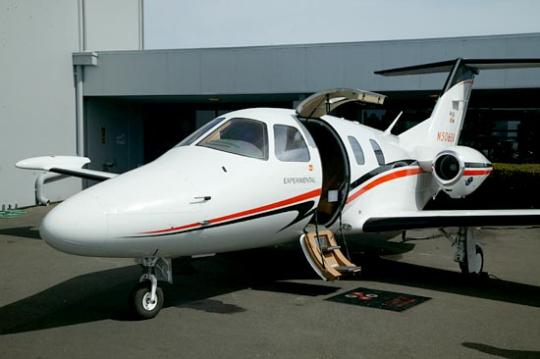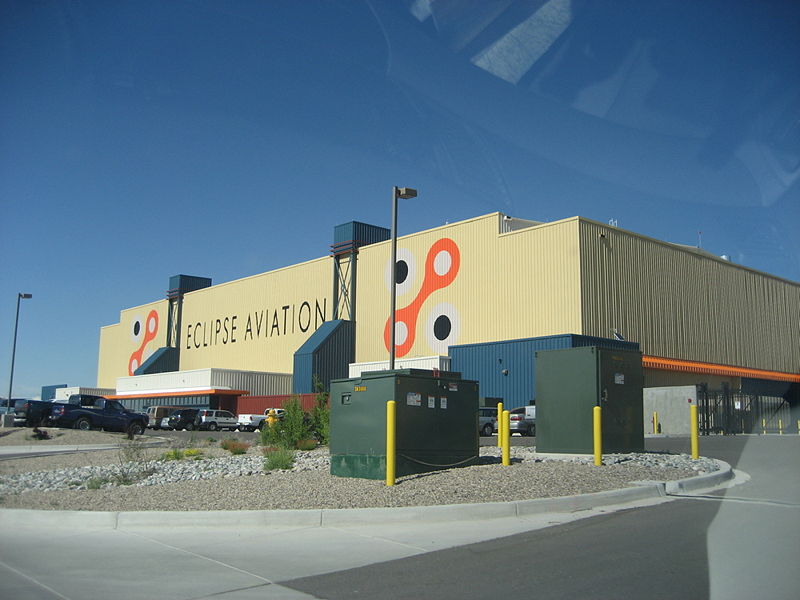First Space-X looses their third Falcon 1 rocket.
Thilert proves that corrupt and fraudulent management and leaving your creditors and customers in the lurch is not an American speciality but rather that the Germans can do quite well at that game too.
Grob, to absolutely no one's surprise, files for insolvency and protection after managing to fatally crash the prototype of an already underfunded and overambitious project.
Columbia Aircraft's subsumation into Cessna (or did that happen in Q2?).
A few other dreamers fell by the wayside, too, unnamed and already forgotten.
 And then finally there has been the slow, bitter meltdown of Eclipse Aviation. At some point, I stopped believing and saw this as something that was bound to come. But not always. Five years ago, Vern's promises sounded good. Revolutionary, almost. A personal jet, a family flivver of the air. At long last Lewis Black and I would have our flying cars.
And then finally there has been the slow, bitter meltdown of Eclipse Aviation. At some point, I stopped believing and saw this as something that was bound to come. But not always. Five years ago, Vern's promises sounded good. Revolutionary, almost. A personal jet, a family flivver of the air. At long last Lewis Black and I would have our flying cars.The marketing materials made that little jet seem so much like that vision of the future. Not quite The Jetsons but pretty damn good. In the post 9/11 world of increased aviation security it seemed like a great idea to get the heck out of the controlled gate-check world and start flying via air taxi or personal jet. The milage was even pretty good -- and the price? Fantastic.
The prototype flew -- did about one turn through the pattern from what I gather, and promptly landed. The engine, Vern insisted, was to blame. I'm willing to believe them. If Williams had, in fact, not completely failed to produce a viable super-mini turbofan then someone else would be trying to put that powerplant back into the air. How's that for a sentence construction, eh? But the FJ22 appears entirely moribund, off the website, almost a memory. Like Keyser Söze, perhaps the FJ22 is now a spook story that jet propulsion engineers tell their kids. Over reach the state of the art...and the FJ22 will get you!
It would not be fair to forget about this debacle of the powerplant. Ever revolution in aircraft design has been preceded or accompanied by a similar advance in engine technology. Without Williams' promised miracle, a quick substitution had to be performed in the form of Pratt & Whitney Canada's glorious little PW610. This was also a baby -- not quite the super-midget of the rejected motor, but still going deeper in to miniature-jet-engine technology than anyone (certainly anyone with the cred of P&W) had gone before. The timing was perfect, even though the fuel consumption, weight, and cost were all going to be higher.
Now I'm not going to let anyone start to toss a bunch of blame onto Pratt & Whitney. There's a genetic thing at work -- my grandfather would pretty much only fly things with P&W motors in them, possibly for superstitious reasons, but the point is the same. They build tanks. P&W Canada's been building miniature turbines in the form of helicopter engines since the 1950's and probably has more operational experience with this size class of jet than all the rest put together. So they know of what they speak and, while the end result may not have been quite as spectacular as was hoped for, it remains an excellent motor.
And perhaps more to the point, the press out of Eclipse was confident and smooth. The new engine would have greater thrust (a feature!) and only slightly higher fuel consumption (a bug) requiring tip tanks (that, I believe, had been planned anyway). No problem, a bit of a delay, just a flesh wound, everything is fine. Flight testing pretty much ground to a halt until a series of design revisions produced more production-like prototypes. These, in due time flew, obtained certification, and appeared on a lot of magazine covers.
And then things started to get a little icky. Customers were obtaining their jets, but with some of the much-vaunted Eclipse features omitted. FIKI (Flight Into Known Icing) certification seemed to draw on forever. Avionics features were placarded off. Blown tires started to become a frequent occurrence (Eclipse blamed operator error but I don't need to spend much time pointing out that a systemic spike in a particular sort of operator error can point to a design flaw that encourages this error...).
Then things got weird. Eclipses were going to be built in Russia. The single engine Eclipse 400 started playing the air show circuit. The hyped avionics architecture was being scrapped in favor of a less integrated system including a couple of off-the-shelf Garmin units. Blogs and chat rooms populated by frustrated, venting customers faced unprecedented legal threats. You'd think that one of the landmark cases on Internet anonymity would revolve around some huge megacorp, but apparently Amazon and Microsoft and General Motors and Delta Air Lines know well enough to let cranky customers have their space and not try to shut them down.
I wonder if they'll try to shut down this blog?
Then, in a so-shocking-it-wasn't-shocking move, Vern Raburn the founder, mouthpiece, and driving force of Eclipse was gone. Forced out by investors. He was to be in charge of "internationlization of production" or something like that. The Russia thing, in other words. Then 100 temps got pink-slipped. Then Vern was gone -- completely. Then a few hundred more got their thank-you-and-goodby (and not all of them temps, I hear).
Now the FAA is conducting a review of the certification process to ensure that the E500 is, indeed, fit to fly and (perhaps more to the point) that the agency followed its own procedures and didn't, like a lot of us, get a bit too excited reading the marketing white papers.
Alright now, this isn't a history lesson or a debrief. I'm not an aerospace engineer or a business analyst but I know a little about both fields. I am a blogger, and therefore have staked out my little piece of the Internet, opinions and all. Eclipse may pull itself together. God knows, when I was among the 25% of Amazon.com staff who got their notice one February afternoon seven years ago, I knew that they were making a necessary move. So this double-pass downsizing at Eclipse may be just such a necessary consolidation of forces. But Amazon was a hugely successful company -- one that had built success by throwing resources (mostly people) at problems and which needed to adapt to a sustainable, profitable architecture. They made the hard choices and did re-architect into something that is doing very well now.
Well, this is a history lesson and a debrief in another sense. I find myself, for the second time in less than a month, writing about over-promising aerospace revolutionaries. I find myself thinking about the seduction of a "better way to do things" and the danger of ignoring the lessons of history. Vern and Elon both knew that the established players were doing things wrong and that they could do it in a different way. So they built teams of like-minded individuals -- doubtless very talented teams with excellent theoretical and practical backgrounds.
I've been part of such teams -- and the Amazon.com thing is going to have to come up again. They/we were a team of folks with brilliant qualifications -- vastly over qualified in many cases -- but just little enough experience to not know that we couldn't do what we are doing. Yes, by the way, I know I'm really working the multiple-negatives here. And yet there was a solid business plan and vision lying on top of all of that. There was a solid financial base -- willing to give enough rope (particularly early on) to run at a staggering loss for a staggeringly long (but ultimately necessary) time.
I used to have a little saying, back in those days, about why Amazon survived when so many struggled and died: some Internet startups were begun by people with good business plans but little grasp of the technology. Others were the products of people with good technological backgrounds and innovative ideas -- but a flawed understanding of the business world. Naturally, there were a few that failed in both regards -- but they didn't usually make it long enough to discuss. Amazon, by contrast, was one of the first (and now the few) to combine a solid business plan with solid technology. Through ups and downs, bad decisions and good decisions, they held close (enough) to the original vision, adapted when necessary, and managed to make it work.
 And now back to Eclipse (and perhaps Space-X). Where is the flaw? Business plan? Technology? Both? Neither? I lean to both -- a technological product that was designed with enough giddy naivety as to be brittle and intolerant of setback and failure -- the failure of the FJ22 and the original avionics system -- and enough cut corners as to generate problems once in service. A business plan that depended on successes in volume production and demand generation that have, so far, eluded them. Eclipse isn't the first to fall to this error -- of assuming or expecting a demand that fails to appear. McDonnell (now Boeing) made the same sad error in planning the Delta IV rocket. Externally a beautiful vehicle, the Delta's approach to cost-effective launch pricing was based around generating a large demand and benefitting from economies of scale in production and launch. For various unfortunate reasons, this failed to appear.
And now back to Eclipse (and perhaps Space-X). Where is the flaw? Business plan? Technology? Both? Neither? I lean to both -- a technological product that was designed with enough giddy naivety as to be brittle and intolerant of setback and failure -- the failure of the FJ22 and the original avionics system -- and enough cut corners as to generate problems once in service. A business plan that depended on successes in volume production and demand generation that have, so far, eluded them. Eclipse isn't the first to fall to this error -- of assuming or expecting a demand that fails to appear. McDonnell (now Boeing) made the same sad error in planning the Delta IV rocket. Externally a beautiful vehicle, the Delta's approach to cost-effective launch pricing was based around generating a large demand and benefitting from economies of scale in production and launch. For various unfortunate reasons, this failed to appear.So now how do I wrap this up? Eclipse has problems -- big problems. I don't think that their layoffs are that sort of "thinning the herd" that can bring a troubled company back. They made big promises and generated and promulgated a lot of enthusiasm. So should we fear companies or products that generate too much enthusiasm? "Woah, there, let's not get too excited..." Should we mistrust companies that promise great change and revolution?
Any of these ideas are naive and simplistic. The reality is, yet again, caveat emptor. When dramatic promises are made -- read the fine print and run your own numbers. When someone promises just a little too much more than everyone else -- make sure you understand how they plan to (or already have) achieved this.
And be sad, at least a little sad, that promise has once again faded into cynicism, layoff, and frustration.
 Cirrus is out there, with a successful line of piston singles and a sexy little jet on the drawing board. Cessna's managed to keep true to their word and move from strength to strength -- including the wonderful little Mustang that just might have contributed more than a little to Eclipse's troubles. Orbital is building a larger-yet rocket from their well understood and consolidated base. So the startups can continue and grow secure. The big guys can show some flexibility and innovation.
Cirrus is out there, with a successful line of piston singles and a sexy little jet on the drawing board. Cessna's managed to keep true to their word and move from strength to strength -- including the wonderful little Mustang that just might have contributed more than a little to Eclipse's troubles. Orbital is building a larger-yet rocket from their well understood and consolidated base. So the startups can continue and grow secure. The big guys can show some flexibility and innovation.So a little sad, but not too much.
1 comment:
Great points N404NE...in fact I'm embarrassed that I didn't remember to put Adam in there as well...but then again, they are almost part of an earlier wave of failed aircraft companies in my mind. The 40% figure surprises me -- does that include companies who fold and reform with new financing/vision/product? But then again, compared to the first wave of home computer or video game companies, there still are a lot of those dot-coms around!
Post a Comment